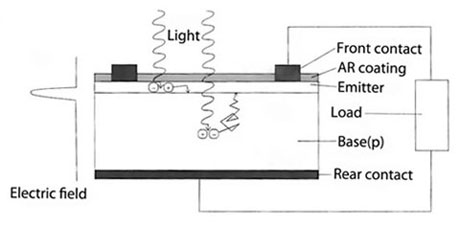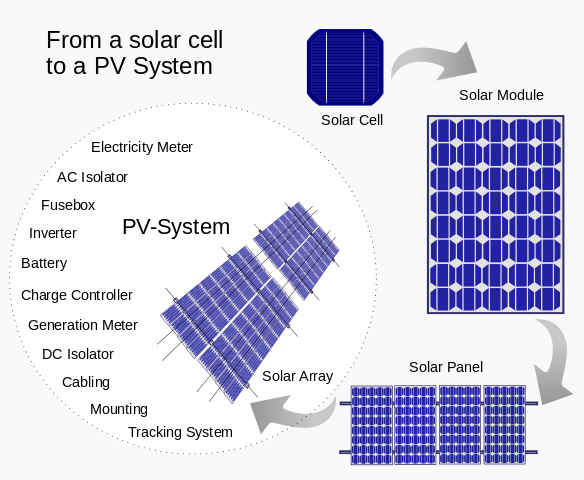Introduction to solar basics
Photovoltaic (or "PV" in short) is a renewable energy form which uses direct conversion of sunlight into electrical energy using devices called solar cells.
As a result of the dramatic decline in prices of solar PV modules during the past years, the adoption of solar has increased considerably around the world with close to 200 GWp (Giga-Watt peak) capacity installed being reached by the end of 2015. Hence, solar could play an important role in the global electricity generation mix in the future.
How Solar Cells Work
 Figure 1: (a) schematic drawing (cross section) of a standard silicon wafer based solar cell. The asymmetric structure of the device (utilisation of p-type doped (p) and n-type doped (n) silicon) causes the selective transport of negative charge carriers (electrons) to the front contact and the transport of positive charge carriers to the rear contact. The typical thickness of such a cell is below 200 µm, the width is approximately 15 cm (square);
Figure 1: (a) schematic drawing (cross section) of a standard silicon wafer based solar cell. The asymmetric structure of the device (utilisation of p-type doped (p) and n-type doped (n) silicon) causes the selective transport of negative charge carriers (electrons) to the front contact and the transport of positive charge carriers to the rear contact. The typical thickness of such a cell is below 200 µm, the width is approximately 15 cm (square);
 Figure 1: (b) photo showing a roof-mounted silicon wafer-based PV system (picture courtesy of Singapore American School, Singapore)
Figure 1: (b) photo showing a roof-mounted silicon wafer-based PV system (picture courtesy of Singapore American School, Singapore)
Almost all solar cells on the market today use semiconductor materials to harness solar energy using the photovoltaic (PV) effect. However, silicon wafer-based technologies dominate today's market. Sunlight can be considered as a flux of particles called photons, whereas electric current is a flux of free (i.e. unbound) electrons. In essence, solar cells convert the energy of a photon flux into energy of an electron flux (see the Figure 1a).
Due to the high density of photons in sunlight, single solar cells generate very large electric currents (of the order of hundreds of Amperes per m2). To reduce the ohmic losses associated with such currents, solar cells are constrained in terms of size (presently to less than 300 cm2). Since solar cells generate relatively low voltages (typically below one Volt) they are generally connected in series to build up voltage. To ensure a long life in outdoor operations, the series-connected solar cells are laminated into a durable package, the so-called PV module (see schematic "from a solar cell to a solar system"). In PV systems, a number of PV modules are connected together (in series and/or in parallel) to achieve the required current and voltage values.
Solar PV and Solar thermal
Solar Thermal: Solar thermal systems actively collect, transport, and utilize solar energy to generate heat. The most common systems are those used to heat water, but there are also systems designed for other applications like space heating and cooking. Another application of solar thermal is in concentrating solar thermal plants which have a number of thermal mirrors which direct the sun light to a central tower containing water which is then converted into steam to drive a turbine to generate electricity.
Solar photovoltaics: These systems can be grid-connected or off-grid systems with batteries for storage. Grid-connected photovoltaic systems, and the majority as found in Singapore, represent the majority of installations around the world. Typically, the energy generated from the solar panels is DC, which has to be converted into AC through an inverter which acts like an interface between the PV system and the grid. Shown below is a breakdown of PV systems based on structure.
 Figure 2: Diagrammatic representation of the various photovoltaic systems
Figure 2: Diagrammatic representation of the various photovoltaic systems
PV System Technologies and Grid Integration
 Figure 3: Conversion from solar cell to module to PV system
Figure 3: Conversion from solar cell to module to PV system
Photovoltaic modules generate direct current (DC) electricity at relatively low voltages (e.g. ~30 V for a standard 250 Wp panel). In most applications, such modules are series-connected in order to generate higher voltages and parallel-connected for higher currents. Such an arrangement of PV modules (shown in Figure 3) is called a PV array or, if larger, a PV power plant.
PV arrays or PV power plants are interconnected with the external electricity grid via power electronic devices (Figure 4(a)). Such devices include safety facilities. The main function of such power electronic units is the conversion of the PV DC power into alternating current (AC) which can be fed into a standard electricity supply grid. These power electronic devices are called "inverters". Low power PV systems are connected to the low voltage distribution grid, while PV power plants are usually connected to the medium voltage grid system. The energy conversion efficiency (DC to AC) of high standard inverters is in the range of 98%.
Power electronic systems of PV installations may incorporate smart controllers, which - in addition to the two-way interaction with the grid - control the electricity flux between the system and onsite loads (Figure 4(b)). More advanced systems may incorporate batteries (electricity storage) in order to achieve a better time matching between PV electricity generation and the demand pattern of the on-site loads (Figure 4(d)). Such batteries may also be used to store PV electricity and feed it with some delay into the grid in times when the electricity demand is particularly high (Figure 4(c)).
 Figure 4: Schematic of grid connected medium power PV systems. (a) PV installation without onsite consumption of electricity; (b) System serving in addition on-site loads, (c) PV system without on-site consumption but additional electricity storage capability, (d) system as (c) with additional onsite loads.
Figure 4: Schematic of grid connected medium power PV systems. (a) PV installation without onsite consumption of electricity; (b) System serving in addition on-site loads, (c) PV system without on-site consumption but additional electricity storage capability, (d) system as (c) with additional onsite loads.
Performance Metrics of Solar Energy System
 Figure 5: Histogram displaying typical losses for a PV system, with a final performance ratio of 80.5% (for illustration purposes only)
Figure 5: Histogram displaying typical losses for a PV system, with a final performance ratio of 80.5% (for illustration purposes only)
Performance Ratio
The performance ratio (PR) in % is a measure of how well a PV system is converting the incoming solar flux into electricity based on (i) the amount of the solar resource reaching the plane of array (POA) of the PV installation and (ii) the nominal system capacity at standard test conditions (STC). It gives the ratio of the actual AC energy yield over the "theoretical" maximum DC yield, based on in-plane irradiance measurements and assuming full DC-to-AC conversion. It is an internationally recognized metric for PV system performance assessment and is used for system evaluation all around the world. It has been adopted by the International Energy Agency (IEA) Photovoltaic Power Systems (PVPS) program and is described in the IEC standard 61724 (1998).
The performance ratio is affected by a number of parameters which include cable losses, soiling of the module surface, temperature effects, and reflection losses among others. It is important to understand the relationship between these parameters and Performance Ratio to design a PV system which minimizes these losses to optimize the energy yield from the system. Well-designed systems in Singapore can reach Performance Ratios of approximately 85%.
Annual Yield
The annual yield is the amount of energy produced per kWp installed with the energy generated from a particular period of interest. This number can be used as a benchmark with the national average to assess how the system performs with respect to others in the region. This component is very specific to the location as it depends on the irradiance available in the area.
